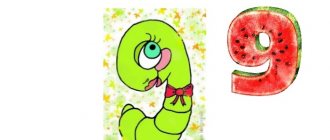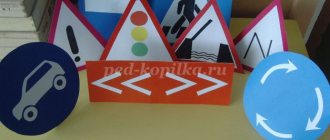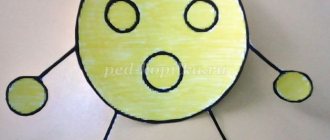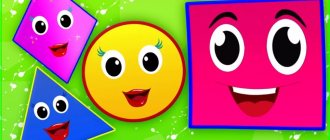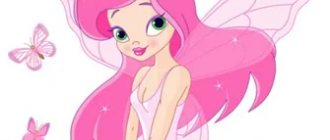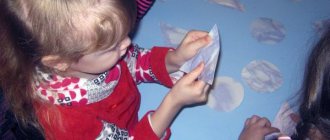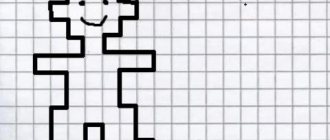MAGAZINE Preschooler.RF
Prepared by teacher: Okorokova E.V. MDOUd,/s. No. 8, Kropotkin-2009 TOPIC: “Numbers from 1 to 10” Purpose: a) summarize and systematize students’ knowledge on the topic “Numbers from 1 to 10”; b) consolidation of knowledge acquired in previous classes; c) determining the location of objects in space; ^consolidate knowledge of adjacent numbers to the named number “before” and “after”. Equipment: animal toys, counting sticks, signal cards, boards, crayons, cubes (red, yellow, green) and triangles, mushrooms / for each correct answer /, ball. PROGRESS OF THE LESSON I. Organizational moment: The bell rang loudly - The lesson begins. Our ears are on top of our heads, our eyes are wide open. We listen, we remember, we don’t waste a minute, Educator: Today a guest came to our lesson, but first we must find out where she is from. To do this, we need to put the numbers in ascending order and decipher the word.On the board: 6 2 4 s l e What word did you get? Children: Forest. Educator: Not a mouse, not a bird came running to us from the forest, frolicking in the forest. Lives in trees and gnaws nuts. Who is this? (Squirrel) /the teacher attaches a drawing of a squirrel to the board/
II. Reporting the objectives of the lesson:
The hostess squirrel opens the school and invites the forest animals to study. Both animals and birds rush to our class, And the squirrel, the teacher, Gives the following order: “Let’s start our lesson, We will repeat the counting and solve examples, Who will learn more carefully,”
Sh. Consolidation of what has been learned: 1).Find the Squirrel mistake. Mishka barely came out from behind the spruce after the little wolf. He shakes his head and talks to himself. Bear. I have a calculating machine, it helps me. I have decided all the examples, but I don’t have the strength to check. Here are the answers in front of you, you, friends, check for yourself. -Children check solved examples. Incorrect results in examples 3 and 4 are removed from the board, and the examples are solved correctly. On the board: 5-1=4 7+1=8 3+2=5 6-5=1 /sign. card./ Squirrel. The beluga bear roared and rushed around in circles. Bear. Ay, car. Well done! Well, you're not at all accurate! Squirrel. Don’t be upset, Mishka, but learn from the kids! Educator: Guys, let’s explain to Mishka again how to add and how to subtract. 2). Composition of the number “5”, Squirrel. A cunning little fox sat under a bush. He listened to the chirping of birds and waited for the prey to come to visit. And we will hide the birds in the houses, But you need to know the composition of the number. On the board are drawings of houses, a fox and birds with numbers on their wings. The guys are moving the birds into houses.
IV. Oral counting: Squirrel. Bunny, bunny, look, name all the figures. Hare. Oh, I don’t know, oh, I’m afraid, For some reason I’m shaking all over. Squirrel. You must answer boldly, but being timid is a bad thing. Which of the guys will help? Educator: Name the figure in the upper left corner, indicate its color. Children: Yellow triangle. Educator: In the lower right corner? Children: Orange square. Educator: Where is the green circle? Children: In the upper right corner. Educator: What kind of figure is this? Children: Oval. Squirrel. I prepared some tablets for you guys. Now pay attention. Let's listen to the task. Draw these figures on your board with chalk from memory. The sample is removed. Children draw. The teacher checks the drawn figures. Squirrel. Write down in the triangle the number that comes before the number b, in the square - after the number 7, in the oval the number that is 1 more than 3, in the circle - 1 less than 9. Summarize the results of this stage of the lesson. V. Development of computing skills. Educator: The gray wolf came running to class, He also wants to master counting, He looks at the examples on the board, How to solve these examples? Help the Wolf, children! Explain to him how to add and subtract 1.2. Children: Add 1 - name the next number when counting, subtract 1 - name the previous one, 2 - add as +1+1, subtract 2 as -1-1, Children solve examples: 3+1 5+2 6-1 7-2 Squirrel. Now make an example about these animals. Here are five bunnies walking along the path. Two people run after them. So how many bunnies are hurrying along the forest path to school in the spring? Children: make a decision at the cash register /write it down on the board/
VI. Physical education lesson The wind is blowing in our faces, / The children are waving their hands at themselves, / The tree is swaying. / The children bend over. / The wind is quieter, quieter, quieter, / The children are crouching. / The tree is getting higher, higher. / Children stand on their toes, stretch upward / VII. Practical work Well done guys, they helped all the animals. And now I’ll give you another task. Build a tower of squares / cubes / so that the red cube is higher than the yellow one, but lower than the green one. - What color was the cube on top? (Green.) - Which cube was lower than the red one? (Yellow.) Place 1 triangle to the right of the tower, and 2 triangles to the left.
VIII. Didactic game: a) “Catch the ball and name the number”; b) “Mathematical Lotto” - (children find the sum of numbers)
IX. Summary of the lesson Squirrel. You, my friends, tried, Everyone worked diligently. I want to thank you and give everyone grades. The teacher evaluates the children's work. Summarizes the work.
| Next > |
Development of mathematical concepts. Composition of a number of units (number 10)
Senior group No. 2
Objectives: 1. Improve knowledge about composing a number from units (the number 10). 2. Fasten:
- ordinal and quantitative counting;
- ideas about the immutability of numbers as a result of changes in the way objects are placed in space;
- knowledge about temporary relationships: week, month.
Demonstration material: 10 figurines of birds and animals. Handouts: small toys: nesting dolls, flowers.
Progress of the lesson
Children stand in front of a board, on which the teacher places animals in a row and reads a poem.
We walked at the zoo and counted the animals. This is a bird, this is an animal, Exactly ten of them, check.
Children count animals and birds and tell the teacher how many there are.
One is a cheerful parrot, Two is a panther. Do not snooze! Three is a mischievous monkey, And four is a miracle bird. Behind the peacock is a lion - he is the fifth. Six – striped tiger cub. Seven - a seal swims in the water. Eight is a reindeer. The bear cub is nine, and the tenth is a swan.
- How many birds are there in total? — How did I make up the number 10? - What is the value of a lion? Seal? Teddy bear? - Who is fourth? Sixth? Tenth? — Shall we now count the animals and birds in order?
The teacher thanks the children and invites them to go to the tables on which small toys lie.
— Place in front of you 1 more nesting dolls than 5. — Now let’s make it so that there are 7 nesting dolls. — Now, boys, take 5 flowers. How many flowers did you take? — Give these flowers to the girls. - Girls, how many flowers did the girls give you? Has the number of colors changed? Why? — Return these flowers to the boys. — Boys, how many flowers did the girls give you? Has the number of colors changed? Why?
Children conclude that the number of objects does not change as a result of their movement. The teacher thanks the children and reinforces with them the names of the days of the week.
— Did I forget what day of the week it is? - What will it be like tomorrow? — What day of the week was yesterday? — What day of the week do you not go to kindergarten? — Let us repeat with you the poem with movements:
I did the laundry on Monday, Paul swept on Tuesday. On Wednesday I baked a loaf of bread, I spent all Thursday looking for a ball, I washed the cups on Friday, and on Saturday I bought a cake. I invited all my girlfriends to my birthday party on Sunday.
Next, the teacher reinforces with the children the knowledge of the months of the year.
— What time of year is it now? What month? - What month does the year begin with? - Which month is the hottest? — Name the last month of the year. — Name the second month of autumn. - Name the third month of spring. — What month comes after October?
The teacher thanks the children for their work.
I used fiction, poems by N. Vladimirov, P. Bashmakov.
